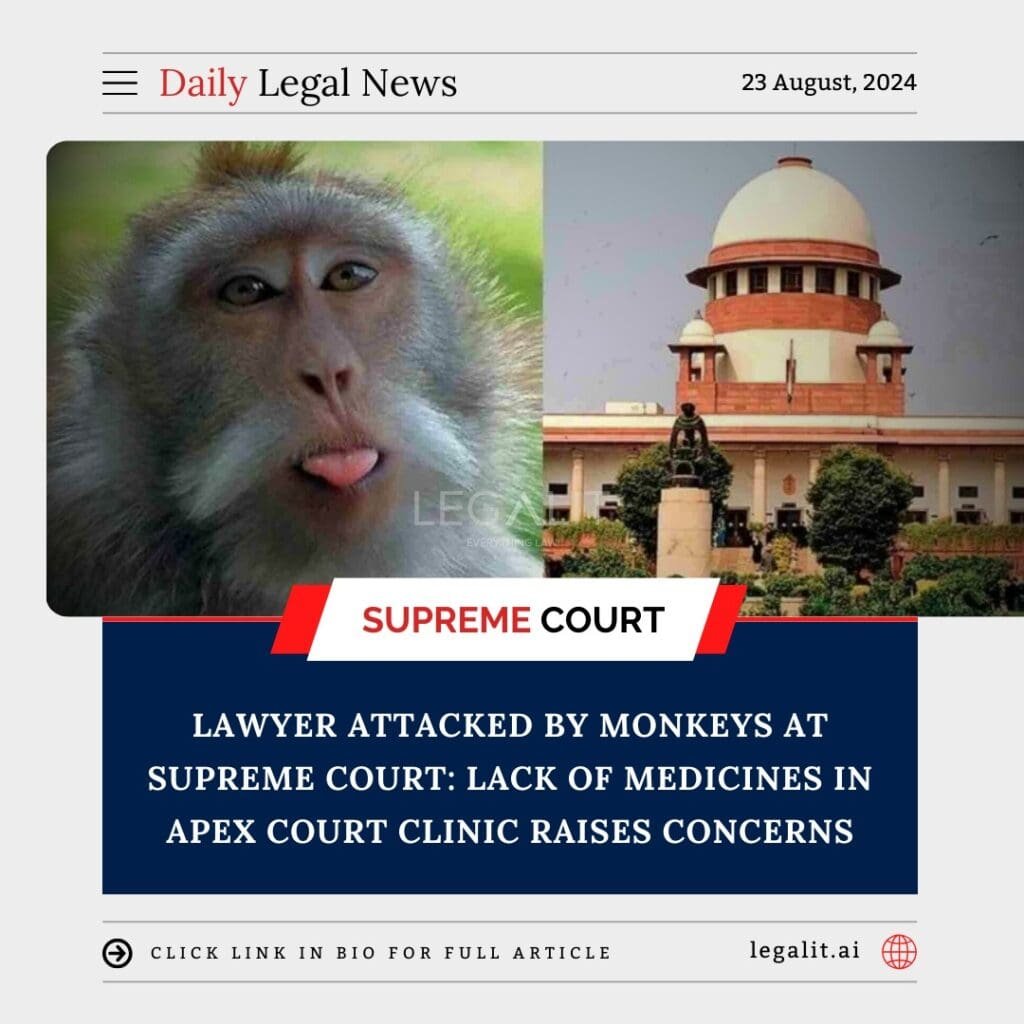
In a bizarre and alarming incident, a lawyer was attacked by a group of monkeys within the premises of the Supreme Court of India. The shocking event has not only raised concerns about safety and security but also highlighted an unexpected gap in the Supreme Court’s healthcare facilities—the absence of essential medicines in the court’s clinic.
The Unusual Incident:
- The Attack: The incident occurred during regular court hours when a lawyer, whose name has been withheld for privacy reasons, was suddenly confronted by a troop of monkeys. The animals, known to frequent certain areas of New Delhi, were reportedly aggressive and attacked the lawyer, causing physical injuries. Witnesses to the attack described the scene as chaotic, with court staff and visitors scrambling to protect themselves from the unruly primates.
- Immediate Response: Following the attack, the injured lawyer sought medical assistance from the clinic located within the Supreme Court premises. The clinic, which is intended to provide first aid and basic medical care to court staff and visitors, was expected to handle such emergencies. However, the situation quickly took an unexpected turn.
Healthcare Concerns:
- Lack of Medicines: Upon arriving at the clinic, the lawyer and those accompanying him were dismayed to discover that the clinic was not adequately stocked with essential medicines. Basic supplies, such as antiseptics, pain relievers, and anti-rabies injections, were reportedly unavailable. This lack of preparedness left the lawyer without the immediate medical attention required after such a traumatic event.
- Potential Risks: The absence of critical medicines in the clinic is particularly concerning given the nature of the injuries. Monkey bites and scratches can lead to serious infections, including rabies, which requires prompt medical intervention. The unavailability of necessary medicines not only delayed treatment but also posed a potential health risk to the victim.
- Implications for Court Staff and Visitors: The incident has broader implications for the thousands of people who visit the Supreme Court daily, including judges, lawyers, clerks, and the general public. The revelation that the court’s clinic lacks essential medical supplies has raised questions about the overall safety and well-being of those within the court’s premises.
Safety and Security Issues:
- Monkey Menace in Delhi: The presence of monkeys in certain parts of New Delhi is a well-known issue, with these animals often causing disruptions and posing risks to residents and visitors alike. However, the attack within the Supreme Court, a highly secure and important institution, underscores the need for more effective measures to manage the monkey menace in such critical areas.
- Security Measures: The incident has sparked a debate over the adequacy of security measures within the Supreme Court. While the court is equipped with extensive security personnel and surveillance systems to prevent human threats, the same level of attention may not have been given to dealing with animal intrusions. This event may prompt a reassessment of security protocols to include measures that address the threat posed by stray animals.
Response from the Authorities:
- Court Administration’s Reaction: In the aftermath of the incident, the Supreme Court administration has faced criticism for the apparent shortcomings in both security and healthcare. The administration has reportedly launched an internal review to address these issues, with a focus on ensuring that the clinic is properly stocked with necessary medical supplies and that additional safety measures are implemented to prevent similar incidents in the future.
- Calls for Action: Members of the legal community have called for immediate action to rectify the gaps in the court’s preparedness. Suggestions include better collaboration with local authorities to control the monkey population in the vicinity of the court, as well as regular audits of the court’s healthcare facilities to ensure they are equipped to handle emergencies.
Broader Concerns and Considerations:
- Healthcare Facilities in Public Institutions: The incident highlights a broader issue regarding the state of healthcare facilities in public institutions. It raises important questions about whether similar gaps might exist in other government buildings and courts across the country, and what measures are in place to ensure that these facilities can adequately respond to emergencies.
- Animal-Human Conflict in Urban Areas: The monkey attack at the Supreme Court is a stark reminder of the ongoing conflict between humans and wildlife in urban areas. As cities expand and natural habitats shrink, incidents of animals entering urban spaces have become more common, leading to potential dangers for both people and animals. Addressing this conflict requires a balanced approach that includes both humane management of wildlife populations and increased public awareness.
- Ensuring Safety in Public Spaces: Ensuring the safety of individuals in public spaces, especially in institutions as critical as the Supreme Court, is of paramount importance. The incident underscores the need for comprehensive safety protocols that address not just human threats but also environmental and wildlife-related risks. Regular training, drills, and updates to emergency response plans can help institutions better prepare for a wide range of scenarios.
Conclusion:
The unexpected monkey attack on a lawyer at the Supreme Court has brought to light significant concerns about safety, security, and healthcare preparedness within one of India’s most important institutions. The incident serves as a reminder that even the most secure environments can have unforeseen vulnerabilities. As the Supreme Court administration works to address these issues, it is hoped that the lessons learned from this event will lead to improved safety measures and better preparedness for any future emergencies. The legal community and the public will undoubtedly be watching closely to see how the court responds to these challenges, with the goal of ensuring that such an incident does not happen again.